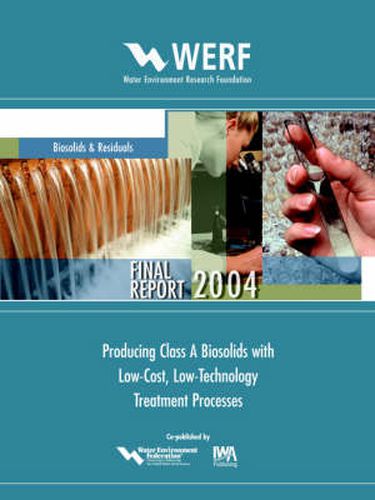Readings Newsletter
Become a Readings Member to make your shopping experience even easier.
Sign in or sign up for free!
You’re not far away from qualifying for FREE standard shipping within Australia
You’ve qualified for FREE standard shipping within Australia
The cart is loading…






Class A biosolids can be produced using low-cost, low-technology biosolids treatment processes including lagoon storage, air drying, and cake storage. This project reviewed the available literature and municipal agency data about these processes. This report presents design and operating guidelines distilled from the review process. It is designed for wastewater treatment plant (WWTP) managers, operators, and engineers who wish to discern whether these processes, used alone or in combination, might be practically applied at specific plants. This report also describes the U.S. regulatory environment in relation to producing Class A Biosolids and defining Class A processes. It also presents a list of recommended research needs. This report: Familiarizes WWTP managers, operators, and engineers with low-cost, low-technology biosolids treatment processes, likely pathogen kill mechanisms, and practices that have reduced pathogen densities to Class A levels at scales ranging from laboratory tests to large municipal biosolids treatment operations. Presents guidelines for producing Class A biosolids under a variety of conditions. Describes low-technology treatment processes within the Class A regulatory framework, identifies satisfactory end conditions for products created from low-tech treatment processes, and provides guidance in developing national or site-specific certification as processes equivalent to a process to further reduce pathogens (PFRP).
$9.00 standard shipping within Australia
FREE standard shipping within Australia for orders over $100.00
Express & International shipping calculated at checkout
Class A biosolids can be produced using low-cost, low-technology biosolids treatment processes including lagoon storage, air drying, and cake storage. This project reviewed the available literature and municipal agency data about these processes. This report presents design and operating guidelines distilled from the review process. It is designed for wastewater treatment plant (WWTP) managers, operators, and engineers who wish to discern whether these processes, used alone or in combination, might be practically applied at specific plants. This report also describes the U.S. regulatory environment in relation to producing Class A Biosolids and defining Class A processes. It also presents a list of recommended research needs. This report: Familiarizes WWTP managers, operators, and engineers with low-cost, low-technology biosolids treatment processes, likely pathogen kill mechanisms, and practices that have reduced pathogen densities to Class A levels at scales ranging from laboratory tests to large municipal biosolids treatment operations. Presents guidelines for producing Class A biosolids under a variety of conditions. Describes low-technology treatment processes within the Class A regulatory framework, identifies satisfactory end conditions for products created from low-tech treatment processes, and provides guidance in developing national or site-specific certification as processes equivalent to a process to further reduce pathogens (PFRP).